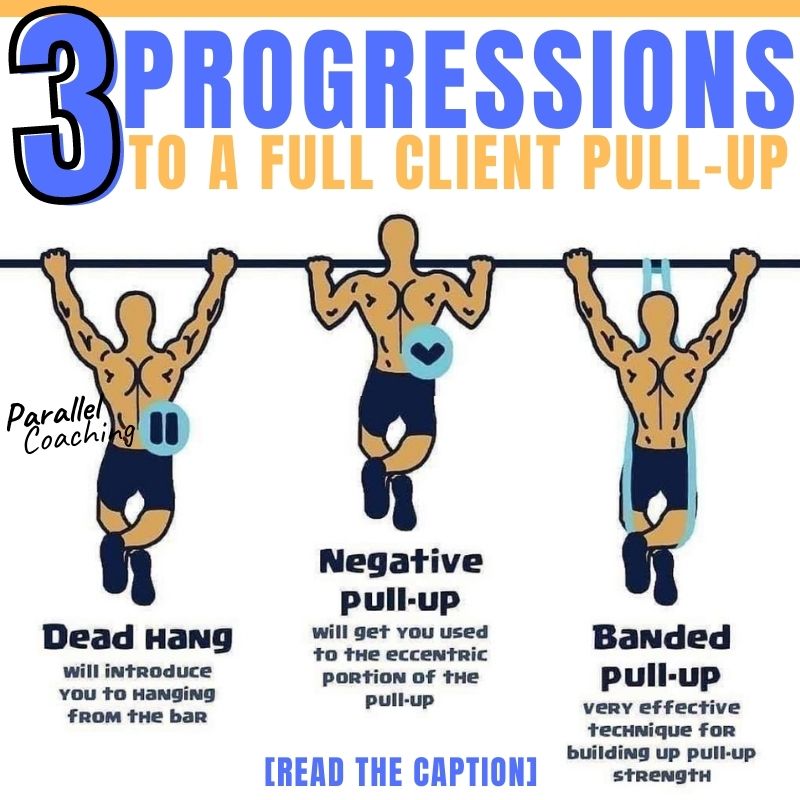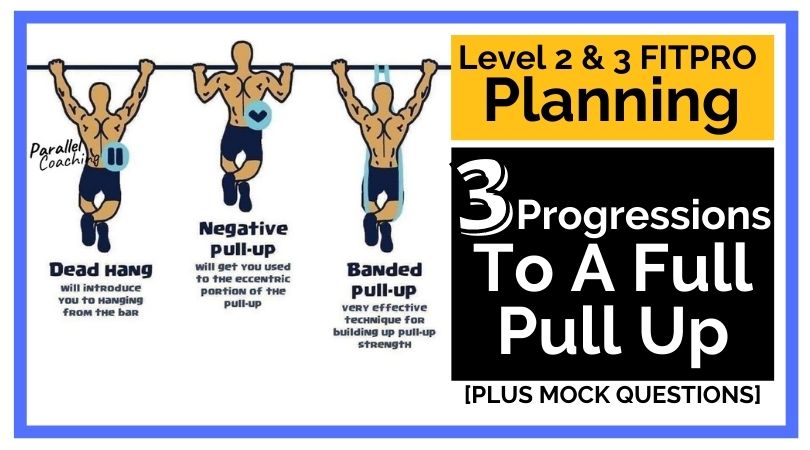In today’s blog, you’ll learn 3 Progressions To A Full Pull Up and how each exercise choice links back to your anatomy and physiology knowledge as a FITPRO
You’ll discover:
- Why the Pull-Up needs regressions and easier options
- What Muscles Are Worked In a Pull-Up?
- 3 Progressions To A Full Pull Up
- How to chose Progressions and Regressions For any exercise
- Test Your Knowledge With Three Mock Questions
[Share this with a client or friend that wants to achieve a full pull-up]
Why the Pull-Up needs regressions and easier options
The Pull-Up is a fantastic bodyweight exercise,
but it is highly likely that your clients are not ready to do a FULL pull-up right away.
Understanding the progressions towards a full pull-up starts with understanding the anatomy and physiology
Once you know the demand that a full pull-up places on the anatomy and physiology of the body, you can mimic that same demand, with less intensity, so the client can gradually progress.
What Muscles Are Worked In a Pull-Up?
The Pull-Up is a big compound, multi joint exercise. Which means it is demanding on multiple large muscles. So let’s see what muscles are worked in a pull up:
Prime Mover: Latissimus Dorsi
Synergist Muscles: Biceps, Trapezius, Core stabilizers, forearm for grip
Main Joint Actions: Shoulder Adduction, and Elbow Flexion
Plane of Motion: Frontal Plane
Axis of Movement: Anterior-Posterior Axis
Once you know the demand of the full version of the exercise, start considering “lower intensity options” that adapt the same muscles, use the same plane of motion, and mimic the same joint actions
Pull Up Progression 1: Dead Hang
The idea of this first step is to address the big fundamental skills and stability required as the foundations of the move.
The client should be able to hold their body weight whilst suspended from the pull-up-bar for at least the duration it would take to complete a full set of pull-ups.
A good target is 40 seconds, based on 10 repetitions at 4 seconds per repetition.
This will challenge the forearm grip endurance And encourage recruitment of core stabilizing muscles, to hold the torso still without swaying or disengagement

Pull Up Progression 2: Negative Pull-Up
If an exercise is so hard that you cannot do ONE rep in the concentric phase, then negatives can be a great way to build strength. We are stronger in the eccentric phase (lowering phase) as we are not resisting gravity.
This means your client can lower down with good technique, but can’t lift up without assistance.
This involves your client “jumping” the concentric (lifting) phase, and then lowering down under control. The biggest benefit of this is that you are now incorporating the exact same joint actions, and the plane of motion as the full pull-up but without the intensity.
The client is stressing the ligaments, tendons and muscles during the eccentric phase, which will help them become stronger in the concentric phase
Pull Up Progression 3: Banded Pull-Up
This final progression is essentially the exact same action as the full pull-up, however with less resistance.
By wrapping a resistance band around the pull-up bar and then hooking this under your client’s knees or feet, part of their body weight will be distributed through the resistance band.
This means that there is less body weight that needs to be lifted and lowered through the prime-mover and synergist muscles. The client gets to refine their coordination, technique, and muscle recruitment ready for the full pull-up without injury.
How to chose Progressions and Regressions For any exercise
Each progression is not just a series of exercises, but careful consideration of variables planned to gradually achieve progressive overload.
Notice the overload is always on the prime mover and synergist muscles, and always in the same plane of motion, but gradually progresses intensity and motor skills.
… and it all came from understanding the anatomical and physiological demand on the body.
[Share this with a client or friend that wants to achieve a full pull-up]
Test your knowledge with 3 Mock Questions
Having learned about progressions to a full Pull up, look at the three Mock questions below. Jot down your answer on scrap paper or as a note on your phone.
Then scroll down to reveal the answers.
1) Which axis of movement does the shoulder move around in a Full Pull Up?
A. Longitudinal
B. Medial-Lateral
C. Frontal
D. Anterior-Posterior
2) Which is the Prime Mover in a Full Pull Up?
A. Latissimus Dorsi
B. Biceps Brachii
C. Deltoids
D. Core Muscles
3) Which of the following is a direct regression of the Full Pull Up?
A. Shoulder Press
B. Banded Pull Up
C. Seated Row
D. Biceps Curl
Answers:
Q1: Answer = D
Q2: Answer = A
Q3: Answer = B
If you want more mock questions like this, then you can download more Free Mock Questions: DOWNLOAD NOW
Progress as a FITPRO…
There are over 17 resistance training systems that are taught in the Level 3 PT syllabus which can be overwhelming to distinguish which system to use and when to plan them. Our FIT-Progressions online programme breaks down each of these in detail with clear protocol to follow for each one.
Plus you learn how to periodise your planning of these systems to allow for logical progressive overload so your client can get their goal every time.
>>>> Join us for FIT-Progressions here

Become a knowledgeable and confident FITPRO, with a clear strategy to get results with your clients every time.
There’s no more self-doubt. There’s no more guessing what to plan or how to get client results. FIT-Progressions has 8 modules and 18 video tutorials that guide you through every stage of your Level 3 Personal Trainer case study, and how to work with clients effectively.
This is for you if you’re…
- struggling to complete your coursework for PT, Yoga, or Pilates
- a newly qualified FITPRO that feels stuck or overwhelmed
- unsure where to start when planning a client session
- worrying about applying your course knowledge with a real client
- doubting you could get results and lack structure to client packages
- anxious and confused about how to get found and get busy
Click the link to find out more and join us:
https://courses.parallelcoaching.co.uk/products/fit-progressions/
Dedicated to More
Hayley “Progressions To A Full Pull Up” Bergman
Parallel Coaching
P.S. You can also find us on the following platforms:
Instagram: https://www.instagram.com/parallelcoaching
Facebook: https://www.facebook.com/ParallelCoaching
Twitter: https://twitter.com/ParallelCoach
YouTube: http://bit.ly/2F1Z1bs
Read more Planning blogs: HERE

